NASA on Monday released two new images of Jupiter from the James Webb Space Telescope that showcase the planet’s features in detail.
The images were captured by the telescope’s near-infrared camera, which uses infrared radiation to detect objects in space.
It is able to observe celestial bodies, such as stars, nebulae and planets, that are too cool or too faint to be observed in visible light, or what is visible to the human eye.
The first image of Jupiter is a composite showing the largest planet in the Solar System against “the black background of space” with swirls of different colors indicating Jupiter’s turbulent atmosphere.

The bright orange glows at the top and bottom of the planet show Jupiter’s Northern and Southern Auroras, respectively, located at both poles.
Also shown in the image is the famous Great Red Spot, which can produce winds of more than 250 miles per hour and is 1.3 times the diameter of Earth, according to NASA. The image shows the spot as white because it is reflecting sunlight and sits at a high altitude.
The second image shows a wider view of Jupiter, including its rings, which are a million times fainter than the planet, according to the space agency.

Also seen are two of Jupiter’s moons — Adrastea and Amalthea — which are located to the far left of the rings.
Although the rest of the image shows the blackness of space, there are fuzzy spots in the lower portion, which are actually faint galaxies glowing in the distance.
“We hadn’t really expected it to be this good, to be honest,” Imke de Pater, a professor emerita of astronomy, earth and planetary science at the University of California, Berkeley, who helped lead the observations of Jupiter, said in a statement. “It’s really remarkable that we can see details on Jupiter together with its rings, tiny satellites, and even galaxies in one image.”



